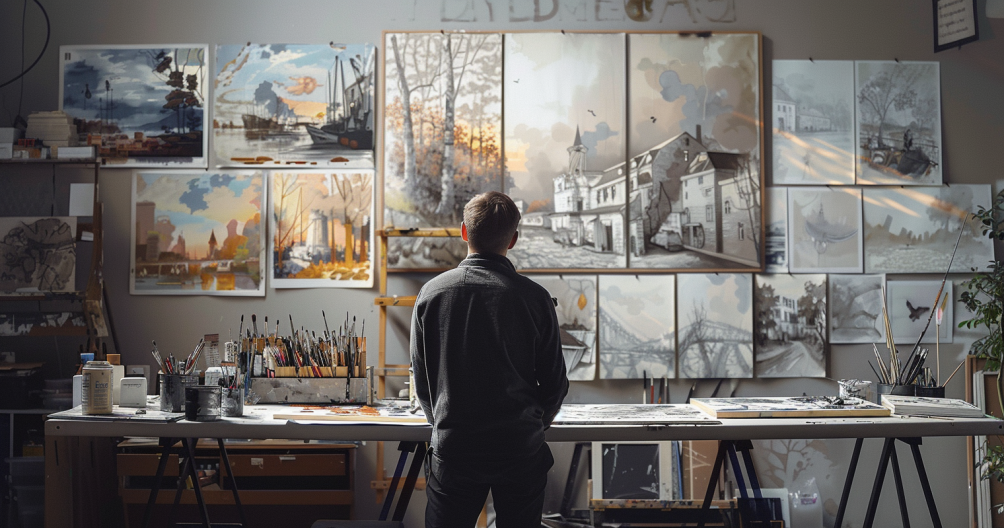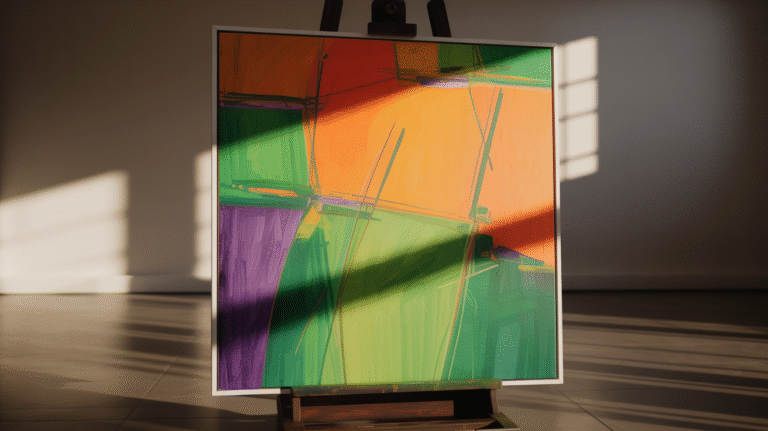Finding your art style can feel big and vague. Good news: you don’t need talent “bursts” or a perfect plan. You need small, steady steps. This guide gives you a simple process, quick exercises, and a 30-day sprint so you can find art style and make work that looks like you.
What Is an Art Style?
Your art style is the consistent look and feel of your work. It’s the mix of choices you repeat on purpose: subject, shapes, line quality, color palette, textures, lighting, and mood. When these choices line up, people recognize your art at a glance.
The 7-Step Plan to Find Your Art Style
1) Collect Inspiration (Week 0)
- Make a mood board of 30–50 pieces you love (books, museums, Pinterest, online galleries).
- Label what you like in each piece: soft edges, limited palette, bold shapes, cozy mood, dramatic light, etc.
- Goal: spot patterns in your taste.
Tip: Add your own past work to the board. Note what still feels “you.”
2) Audit Your Art
Skim your last 20–50 pieces and mark recurring elements:
- Subjects: people, plants, architecture, fantasy, pets
- Colors: muted earth tones, neon accents, blues + oranges
- Lines/Brushwork: sketchy, smooth, chunky, textured
- Mood: calm, whimsical, eerie, high-energy
Keep the top 3–5 elements that feel most natural and exciting.
3) Choose Your Style Pillars
Pick three pillars you’ll commit to for one month:
- Subject focus: e.g., “cozy interiors with plants”
- Palette rule: e.g., “5 colors only—two warms, two cools, one accent”
- Line/texture rule: e.g., “thick outlines + dry-brush texture”
These constraints make your work cohesive fast.
4) Build Your Signature Toolkit
Select tools you’ll use for the sprint:
- Medium: pencil + gouache, acrylic, watercolor, markers, or digital
- Brush/pen set: 2–3 brushes or nibs you’ll repeat
- Composition habit: centered portraits, rule-of-thirds, wide shots
- Lighting: rim light, backlight, soft overcast
- Texture trick: paper grain, stippling, palette-knife scrapes
Keep it small. Repetition creates style.
5) Do a 30-Day Style Sprint (15 – 45 min/day)
Use this schedule or loop any set you like:
Days 1–5 – Foundations
- 10 thumbnails of your subject.
- Value study (3 values only).
- Color map using your 5-color palette.
- Line tests (thin, thick, broken).
- Texture sheet (hatching, dry-brush, dots).
Days 6–10 – Mini Pieces
6–10. Make one small finished piece per day (postcard size).
Days 11–15 – Master Studies (No Posting)
- Do 3 studies of artists you admire. Match value and shape, not details.
- Then do 2 “inspired” pieces: switch to your subject and palette.
Days 16–20 – Style Mash-ups
- Combine two influences into your subject (e.g., impressionist color + graphic lines).
Days 21–25 – Series Building
- Create a 5-piece mini series with one theme (e.g., “Morning Corners”).
Days 26–30 – Refine + Present
- Pick your best 6–9 works.
- Tweak color consistency.
- Write a 1-sentence Style Statement (see below).
6) Ask for Critique (Smart + Safe)
- Share only the series (not every sketch).
- Ask 3 focused questions:
- What feels consistent?
- What feels off-brand?
- Which piece is most “me,” and why?
- Keep what aligns with your pillars. Drop the rest.
7) Name and Share Your Style
Write your Style Statement:
“I create [mood] [subject] using [key techniques] and a [palette type] palette.”
Example: “I create cozy plant-filled interiors with bold outlines, chunky brushwork, and warm muted colors.”
Use that line in your bio, shop, and portfolio. Consistency builds recognition.
Study Artists Without Losing Your Voice
- Master study → transform: copy to learn, then redo with your subject and palette.
- Technique, not identity: borrow how they layer paint or simplify shapes, not their exact look.
- Two-influence rule: when you mash styles, add your own subject and color choices so the mix becomes yours.
Quick exercises
- 3-value study of a favorite piece, then apply those values to your own scene.
- Turn a photo into five big shapes; paint only those.
Inspiration Sources (That Actually Work)
- Real life: your room, commute, local cafés.
- Nature: plants, weather, textures (bark, rust, stone).
- Culture: textiles, posters, packaging, vintage stamps.
- Personal: hobbies, memories, small rituals (morning coffee).
- Constraints: draw the same subject for 10 days—watch it become you.
Common Mistakes (and Fixes)
- Too many tools: pick 1–2 mediums for a month.
- Palette chaos: fix to 5 colors; adjust only one at a time.
- Inconsistent subjects: build a mini series around one theme first.
- Posting every experiment: curate. Show the series, not the noise.
- Quitting early: most styles “click” after 20–30 small pieces, not 2–3.
Quick Style-Builder Checklist
- Mood board (50 refs) with labels
- Style pillars (subject, palette, line/texture)
- Toolkit (2–3 brushes/pens, 1 medium)
- 30-day sprint plan
- Best 6–9 pieces selected
- One-sentence Style Statement
- Portfolio/social updated
Video: Study + Transform (Recommended)
Watch and then try the master-study → transform workflow:
https://www.youtube.com/watch?v=wNdeijnUNo8
FAQ: How to Find Art Style
How do I find my unique art style?
Follow a short cycle: collect inspiration → choose 3 style pillars → make a 30-day series → get critique → refine. Keep your toolkit and palette limited so your look becomes consistent.
How do I study an artist’s style without copying?
Do private studies to learn values, shapes, and rhythm. Then switch to your subject and palette. Share the transformed result, not the study.
What does my art style say about me?
Your style reflects repeated choices, subjects you care about, colors you feel safe in, and the energy in your lines. Those patterns communicate your mood, values, and point of view.
Short Glossary of Popular Styles (Fast Reference)
- Impressionism: short strokes, light + color over detail.
- Expressionism: bold color and distortion to show emotion.
- Realism: accurate, detailed life depiction.
- Abstract: shapes and color carry meaning more than subjects.
- Or take a look at my article about Modern Art
Use these as study themes, then bend them toward your pillars.
Final Push (Try This Today)
- Write your three pillars.
- Pick a 5-color palette.
- Make one postcard-size piece in 30 minutes.
- Repeat tomorrow.
Your style isn’t found in a single breakthrough. It’s built by clear choices, small limits, and steady practice. Start your sprint, and let your work start looking like you.






